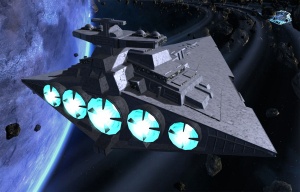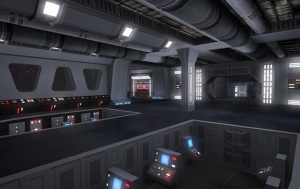
|
Legends Article This page contains information from the Star Wars Legends continuity and may not be supported by the Dark Brotherhood.
|
| Brotherhood-class Star Battlecruiser
|
|
Kuat Drive Yards
|
|
Star Battlecruiser
|
|
Brotherhood-class
|
|
~805,640,000
|
|
4,000 meters
|
- Class One
- Backup: Class Ten
|
|
Verpine Navigator SPS
|
- Heavy dual turbolasers (60)
- Firing Arc: 10 fore, 10 aft, 20 port, 20 starboard
- Firing Arc: 30 fore, 20 aft, 50 port, 50 starboard
- Firing Arc: 20 fore, 10 aft, 30 port, 30 starboard
- Point-defense laser cannons (40)
- Firing Arc: 10 fore, 10 aft, 10 port, 10 starboard
- Assault concussion missile tubes (100)
- Firing Arc: 20 fore, 40 port, 40 starboard
- Ammunition: 40 missiles per tube
- Tractor beam projectors (15)
- Firing Arc: 3 fore, 2 aft, 5 port, 5 starboard
|
- 144 Starfighters
- 40 shuttles & aux craft
|
|
|
|
3,500
|
|
21,160 troops
- Prefabricated garrison base
|
|
145,000 metric tons
|
|
6 years
|
|
Dark Jedi Brotherhood Era
|
The Brotherhood-class Star Battlecruiser was the largest of the five classes of warships gained by the Dark Brotherhood through Operation Tempest Bravo in 24 ABY. Based on the hull of the Clone Wars era Praetor-class Star Battlecruiser, the class was an excellent multi-role platform and could easily standing toe to toe with similar vessels fielded by the Galactic Alliance. The single Brotherhood-class vessel constructed, Nightfall, serves as command ship of the Navy of the Iron Throne.
Characteristics
Dimensions
 Brotherhood-class aft.
Brotherhood-class aft.The 4,000 meter hull of the Brotherhood-class had roughly the same proportions and hull layout as the ubiquitous Imperial-class destroyers. The most obvious difference is the larger superstructure atop the dorsal surface of the hull. This superstructure emerged from the main hull much farther forward of where it does on an Imperial-class, and had larger terrace structures climbing towards the main bridge tower at the aft.
Like many larger battlecruisers and dreadnoughts, the Brotherhood-class mounted an oversize reactor system deep within the hull. As a result, the protruding reactor bulge found in other destroyer type ships is absent. The reactor systems also fed the large main engines found along the aft. The engine array mirrored that found in designs such as the Executor-class by omitting secondary engine systems of varied sizes and instead incorporating a large bank of similarly sized main engines. The five engines of the Brotherhood-class are of slightly different size and provide differing levels of thrust output, but they are all based on the same basic engine system.
Crew Requirements
When the engineers of Kuat Drive Yards worked to adapt the existing Praetor design to meet the Brotherhood’s needs, one of the first areas they attempted to address was the massive crew originally needed to operate the vessel. Like most capital ships of the Clone Wars era, the Praetor had a far larger crew than comparable modern vessels. Using greater levels of automation and droid support, this number was reduced to just under seventy-five thousand. The Brotherhood-class design also incorporated expanded crew support to accommodate its larger troop capacity.
Offensive and Defensive Systems
As seen with several other Kuati battlecruisers and dreadnoughts, the Brotherhood-class does not carry what many would consider an overwhelming number of energy weapons. The ship instead mounts extensive missile systems to complement a still heavy turbolaser and ion canons armament. The energy weapons are used to bring down the shields of an opposing vessel, even if only for a limited duration, and then the missile systems are tasked to inflict catastrophic damage quickly with massed projectile fire. Many of the ship's flank weapons are placed along the edges running the length of the vessel, allowing most of them to engage targets forward as well.
One of the major reasons to favor the missile systems with their lower energy demands over expanding the ship's turbolaser or ion cannon weapons was to direct more power to the shield systems. The Praetor design upon which it is based already boasted an impressive shield capacity, and the design expands on this using newer technology and more raw power. In addition to shield systems second to none, the Brotherhood-class also mounted equally heavy armor. The ship's structure used doonium, as do most starship designs, but added heavy durasteel plating that is half again the thickness used to armor Imperial-class vessels. This armor, combined with the shield systems, meant the Brotherhood-class could stand toe to toe with entire squadrons of destroyer class vessels and easily hold off even larger Star Dreadnoughts.
Complement
To supplement its own offensive systems the Brotherhood-class carried a fighter complement of two full Imperial wings totalling 144 starfighters. The flight decks were optimized to host larger, hyperspace capable designs as opposed to less effective fighter craft such as the TIE/ln or TIE/sa. These craft are also tasked with ensuring the safety of the vessel’s landing craft and shuttles during planetary assault and boarding operations.
In addition to starfighters and other auxiliary craft, the Brotherhood-class was also capable of fielding a large ground force of 21,160 men, two full legions. The vessel also embarked full mechanized and armored support for the infantry complement, giving the Brotherhood-class the ability to engage in full planetary assault operations without further support.
History
Origin
 The bridge of a Brotherhood-class Dreadnaught.
The bridge of a Brotherhood-class Dreadnaught.The Praetor-class design that would serve as the basis for the Brotherhood-class Star Battlecruiser began as follow on to the Procurator-class Star Battlecruiser. The Procurator had originally served as part of the Kuat Sector's sectorial fleet, and would become part of the Republic Navy when the Kuati force was nationalized by the starwars:Republic following the Battle of Rendili in 20 BBY. The Procurator, like other Kuat vessels of the time, was however ill suited to the vast expanse of territory the Clone Wars covered given her limited hyperspace range. The designers of Kuat Drive Yards were then tasked with developing a more capable platform. The Praetor would fall in size and capability somewhere between the Procurator and the larger Mandator line at a size of 4,000 meters.
The Praetors would go on to see service throughout the Clone Wars in limited numbers, taking place in several engagements. As the Republic Navy gave way to the starwars:Imperial Navy, the Praetor made the transition and continued to serve. They would see duty hunting down Separatist hold outs and serving as sector defense craft. The class was eventually superseded by the Praetor Mark II shortly after the Declaration of the New Order. Both of the designs fell out of favor with the Imperial leadership, however, as they lacked the versatility of smaller Star Destroyer designs while also failing to project the sort of terror that the larger Star Dreadnoughts were capable of. They would continue to serve throughout the Imperial period, mostly relegated to the defense of key regions in the Core.
The battlecruiser design would languish in KDY's databases for decades as the company shifted production first to Star Destroyers for the Empire and then the New Republic. This all changed in 25 ABY when agents acting on behalf of the Brotherhood entered into negotiations with KDY in order to secure build contracts for new capital starships. Chief among these ships would be a design of a larger vessel to serve as a new flagship. They had been looking at production of a vessel based on the Allegiance-class design, but the Praetor better suited their design needs as it could also be adapted to fulfill the requirements of transporting the Army of the Iron Throne's expeditionary forces.
Service
Due to size and complexity, the Brotherhood-class Nightfall was the first of the Tempest Bravo vessels to begin construction and nearly the last to be completed. The Nightfall was then transferred to Roche along with the rest of the operational vessels for a final fitting out. These upgrades focused mainly on defensive systems and included sensor upgrades and ion shielding. The Nightfall was then delivered to the Navy of the Iron Throne and commissioned into service as the fleet’s command ship.